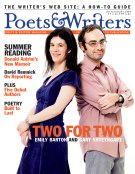Despite Moody’s resistance, I was now convinced that a Web site was necessary, and I continued to gather information. I knew there were people, somewhere, who designed Web sites, but I didn’t know where that somewhere was. Then I recalled a casual acquaintance, a deeply talented graphic designer named Dan Miller, who did “something” on the Web. It turns out that Dan owns his own Web design company, exhibit-E (www.exhibit-e.com), which specializes in designing Web sites for the art world, including some of the world’s top galleries and dealers. At the request of several of Dan’s artist-friends, exhibit-E also developed a template for visual artists, allowing individuals to create lush-looking sites for a fraction of the typical cost. So I thought to myself, “Why not develop an author’s template?”
It gives me great pleasure to have been involved in designing something that offers authors another option for creating a high-end Web site at a relatively low cost—under twenty-five hundred dollars.
To investigate the idea further, Dan and I threw a dinner party at author Patricia McCormick’s house and invited about a dozen writers, many of them members of the Writers Room, a non-profit writers space in New York City, to meet with Dan and his design team and talk about what an author needs on a Web site—how it should look and how it could function. We discussed how basic images and text could introduce the writer on the home page; the elements of the author’s biographical page; having a section for each of the author’s books, as well as separate sections for a discussion about craft or process, an excerpt or a sample of forthcoming work, reviews, and a readers or teachers guide; links to stores selling the books online; and, perhaps most important, a way for users to contact or communicate with the writer.
We discussed the idea of creating a template that could incorporate all of these elements and give writers the ability not only to customize the design but also to change text and images on their own, whenever they desired. To keep the cost down, each site built from the template would fit within certain parameters; certain fixed things about the site would remain the same for each author—the location of the pull-down menu, for example, and some of the typefaces. But beyond that, the text, the images, the number of pages, and the content of the pages would be unique to each author’s site.
The most incredible thing happened. Dan really listened, and at the next meeting, this time at the Writers Room, in front of a larger, more vocal group, he presented the template design and showed how writers would be able to maintain their sites on their own. There were a lot of oohs and ahs as well as some dissent. But soon after the meeting, three author sites were launched.
It gives me great pleasure to have been involved in designing something that offers authors another option for creating a high-end Web site at a relatively low cost—under twenty-five hundred dollars. And the site can be accessed and updated by the author herself, so that if a great review appears in a newspaper, she can get it up on the site for everyone to see within minutes. Not only are they beautiful sites, elegant and efficient, but they are simple and easy to use.








